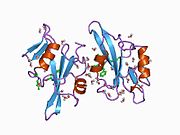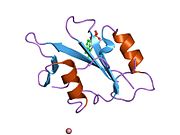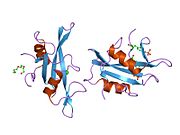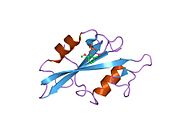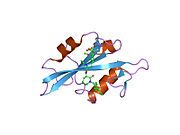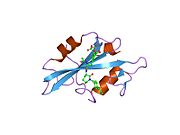Src (gen)
Src je proto-onkogenska tirozinska kinaza. Src su otkrili Mihael Bišop i Harold Varmus. Za ovo otkriće im je dodeljena Nobelova nagrada za fiziologiju ili medicinu 1989. godine.[1] Ova kinaza pripada familiji nespecifičnih proteinskih tirozinskih kinaza koja se naziva Src familijom kinaza. Otkriće Src porodice proteina je imalo presudnu ulogu u modernom shvatanju rak kao bolesti u kojoj se inače zdrava ćelijska signalizacija pokvari.
Ovaj gen je sličan sa v-src genom Rous sarkoma virusa. Ovaj proto-onkogen može da igra ulogu u regulisanju embrionalnog razvoja i rasta ćelija. Proteinska kinaza koju ovaj gen kodira se može inhibirati fosforilacijom c-SRC kinazom. Mutacije ovog gena mogu da učestvuju u malignom razvoju raka debelog creva. Dve transkriptne varijante koje kodiraju isti protein su nađene za ovaj gen.[2]
Interactions
[уреди | уреди извор]Za Src gen je bilo pokazano da interaguje sa GRIN2A,[3][4] C-Raf,[5] CD44,[6] Jedreni translokator arilnog ugljovodoničnog receptora,[7] Aryl hydrocarbon receptor,[7] PDE6G,[8] STAT1,[9][10] EPH receptor B2,[11][12] Androgenski receptor,[13][14][15] Proteinska kinaza Mζ,[16] STAT3,[17] Grb2,[8][18] Beta-3 adrenergički receptor,[19] Kinaza beta adrenergičkog receptora,[8] Receptor epidermalnog faktora rasta,[9][20][21] PTK2,[22][23][24][25][26][27] DAB2,[28] EPS8,[29] Distroglikan,[30] Estrogenski receptor alfa,[13][31][32][33] Estrogenski receptor beta,[13][33] HNF1A,[34] KHDRBS1,[35][36][37][38][39] DDEF1,[40] MUC1,[41][42] PTK2B,[20][43][44] BCAR1,[45][22][46][47][48][24] SHB,[49] PLD2,[50] Faktor responsa seruma,[51] NCOA6,[52][53][54][55] Receptor retinoiske kiseline alfa,[32][56] Protein Viskot-Oldrić sindroma,[57][58] RICS,[59] RAS p21 proteinski activator 1,[60][61] MT-ND2[62] i GNB2L1.[63]
Reference
[уреди | уреди извор]- ^ Nobel Prize in Physiology or Medicine for 1989 jointly to J. Michael Bishop and Harold E. Varmus for their discovery of "the cellular origin of retroviral oncogenes". Press Release.
- ^ „Entrez Gene: SRC v-src sarcoma (Schmidt-Ruppin A-2) viral oncogene homolog (avian)”.
- ^ Ma, Juan; Zhang Guang-Yi (2003). „Lithium reduced N-methyl-D-aspartate receptor subunit 2A tyrosine phosphorylation and its interactions with Src and Fyn mediated by PSD-95 in rat hippocampus following cerebral ischemia”. Neurosci. Lett. Ireland. 348 (3): 185—9. ISSN 0304-3940. PMID 12932824. doi:10.1016/S0304-3940(03)00784-5.
- ^ Takagi, N; et al. (1999). „The effect of transient global ischemia on the interaction of Src and Fyn with the N-methyl-D-aspartate receptor and postsynaptic densities: possible involvement of Src homology 2 domains”. J. Cereb. Blood Flow Metab. UNITED STATES. 19 (8): 880—8. ISSN 0271-678X. PMID 10458595. doi:10.1097/00004647-199908000-00007.
- ^ Cleghon, V; Morrison D K (1994). „Raf-1 interacts with Fyn and Src in a non-phosphotyrosine-dependent manner”. J. Biol. Chem. UNITED STATES. 269 (26): 17749—55. ISSN 0021-9258. PMID 7517401.
- ^ Bourguignon, L Y; et al. (2001). „CD44 interaction with c-Src kinase promotes cortactin-mediated cytoskeleton function and hyaluronic acid-dependent ovarian tumor cell migration”. J. Biol. Chem. United States. 276 (10): 7327—36. ISSN 0021-9258. PMID 11084024. doi:10.1074/jbc.M006498200.
- ^ а б Beischlag, Timothy V; et al. (2002). „Recruitment of the NCoA/SRC-1/p160 family of transcriptional coactivators by the aryl hydrocarbon receptor/aryl hydrocarbon receptor nuclear translocator complex”. Mol. Cell. Biol. United States. 22 (12): 4319—33. ISSN 0270-7306. PMC 133867
 . PMID 12024042. doi:10.1128/MCB.22.12.4319-4333.2002.
. PMID 12024042. doi:10.1128/MCB.22.12.4319-4333.2002.
- ^ а б в Wan, Kah Fei; et al. (2003). „The inhibitory gamma subunit of the type 6 retinal cGMP phosphodiesterase functions to link c-Src and G-protein-coupled receptor kinase 2 in a signaling unit that regulates p42/p44 mitogen-activated protein kinase by epidermal growth factor”. J. Biol. Chem. United States. 278 (20): 18658—63. ISSN 0021-9258. PMID 12624098. doi:10.1074/jbc.M212103200.
- ^ а б Olayioye, M A; et al. (1999). „ErbB receptor-induced activation of stat transcription factors is mediated by Src tyrosine kinases”. J. Biol. Chem. UNITED STATES. 274 (24): 17209—18. ISSN 0021-9258. PMID 10358079. doi:10.1074/jbc.274.24.17209.
- ^ Cirri, P; et al. (1997). „c-Src activates both STAT1 and STAT3 in PDGF-stimulated NIH3T3 cells”. Biochem. Biophys. Res. Commun. UNITED STATES. 239 (2): 493—7. ISSN 0006-291X. PMID 9344858. doi:10.1006/bbrc.1997.7493.
- ^ Zisch, A H; et al. (1998). „Complex formation between EphB2 and Src requires phosphorylation of tyrosine 611 in the EphB2 juxtamembrane region”. Oncogene. ENGLAND. 16 (20): 2657—70. ISSN 0950-9232. PMID 9632142. doi:10.1038/sj.onc.1201823.
- ^ Zisch, A H (2000). „Replacing two conserved tyrosines of the EphB2 receptor with glutamic acid prevents binding of SH2 domains without abrogating kinase activity and biological responses”. Oncogene. ENGLAND. 19 (2): 177—87. ISSN 0950-9232. PMID 10644995. doi:10.1038/sj.onc.1203304.
- ^ а б в Migliaccio, A; et al. (2000). „Steroid-induced androgen receptor-oestradiol receptor beta-Src complex triggers prostate cancer cell proliferation”. EMBO J. ENGLAND. 19 (20): 5406—17. ISSN 0261-4189. PMC 314017
 . PMID 11032808. doi:10.1093/emboj/19.20.5406.
. PMID 11032808. doi:10.1093/emboj/19.20.5406.
- ^ Unni, Emmanual; et al. (2004). „Changes in androgen receptor nongenotropic signaling correlate with transition of LNCaP cells to androgen independence”. Cancer Res. United States. 64 (19): 7156—68. ISSN 0008-5472. PMID 15466214. doi:10.1158/0008-5472.CAN-04-1121.
- ^ Powell, S M; et al. (2004). „Mechanisms of androgen receptor signalling via steroid receptor coactivator-1 in prostate”. Endocr. Relat. Cancer. England. 11 (1): 117—30. ISSN 1351-0088. PMID 15027889. doi:10.1677/erc.0.0110117.
- ^ Seibenhener, M L; et al. (1999). „Identification of Src as a novel atypical protein kinase C-interacting protein”. Mol. Cell Biol. Res. Commun. UNITED STATES. 2 (1): 28—31. ISSN 1522-4724. PMID 10527887. doi:10.1006/mcbr.1999.0140.
- ^ Cao, X; et al. (1996). „Activation and association of Stat3 with Src in v-Src-transformed cell lines”. Mol. Cell. Biol. UNITED STATES. 16 (4): 1595—603. ISSN 0270-7306. PMC 231145
 . PMID 8657134.
. PMID 8657134.
- ^ Saci, Abdelhafid; et al. (2002). „Differential effect of the inhibition of Grb2-SH3 interactions in platelet activation induced by thrombin and by Fc receptor engagement”. Biochem. J. England. 363 (Pt 3): 717—25. ISSN 0264-6021. PMC 1222524
 . PMID 11964172. doi:10.1042/0264-6021:3630717.
. PMID 11964172. doi:10.1042/0264-6021:3630717.
- ^ Cao, W; et al. (2000). „Direct binding of activated c-Src to the beta 3-adrenergic receptor is required for MAP kinase activation”. J. Biol. Chem. UNITED STATES. 275 (49): 38131—4. ISSN 0021-9258. PMID 11013230. doi:10.1074/jbc.C000592200.
- ^ а б Keely, S J; et al. (2000). „Carbachol-stimulated transactivation of epidermal growth factor receptor and mitogen-activated protein kinase in T(84) cells is mediated by intracellular ca(2+), PYK-2, and p60(src)”. J. Biol. Chem. UNITED STATES. 275 (17): 12619—25. ISSN 0021-9258. PMID 10777553. doi:10.1074/jbc.275.17.12619.
- ^ Sato, K; et al. (2000). „Adaptor protein Shc undergoes translocation and mediates up-regulation of the tyrosine kinase c-Src in EGF-stimulated A431 cells”. Genes Cells. ENGLAND. 5 (9): 749—64. ISSN 1356-9597. PMID 10971656. doi:10.1046/j.1365-2443.2000.00358.x.
- ^ а б Hsia, Datsun A; et al. (2003). „Differential regulation of cell motility and invasion by FAK”. J. Cell Biol. United States. 160 (5): 753—67. ISSN 0021-9525. PMC 2173366
 . PMID 12615911. doi:10.1083/jcb.200212114.
. PMID 12615911. doi:10.1083/jcb.200212114.
- ^ Hecker, Timothy P; et al. (2002). „Focal adhesion kinase enhances signaling through the Shc/extracellular signal-regulated kinase pathway in anaplastic astrocytoma tumor biopsy samples”. Cancer Res. United States. 62 (9): 2699—707. ISSN 0008-5472. PMID 11980671.
- ^ а б Angers-Loustau, A; et al. (1999). „Protein tyrosine phosphatase-PEST regulates focal adhesion disassembly, migration, and cytokinesis in fibroblasts”. J. Cell Biol. UNITED STATES. 144 (5): 1019—31. ISSN 0021-9525. PMC 2148201
 . PMID 10085298. doi:10.1083/jcb.144.5.1019.
. PMID 10085298. doi:10.1083/jcb.144.5.1019.
- ^ Relou, Ingrid A M; et al. (2003). „Site-specific phosphorylation of platelet focal adhesion kinase by low-density lipoprotein”. Biochem. J. England. 369 (Pt 2): 407—16. ISSN 0264-6021. PMC 1223094
 . PMID 12387730. doi:10.1042/BJ20020410.
. PMID 12387730. doi:10.1042/BJ20020410.
- ^ Messina, Samantha; et al. (2003). „Specific interactions of neuronal focal adhesion kinase isoforms with Src kinases and amphiphysin”. J. Neurochem. England. 84 (2): 253—65. ISSN 0022-3042. PMID 12558988. doi:10.1046/j.1471-4159.2003.01519.x.
- ^ Lebrun, P; et al. (1998). „Insulin receptor substrate-1 as a signaling molecule for focal adhesion kinase pp. 125(FAK) and pp. 60(src)”. J. Biol. Chem. UNITED STATES. 273 (48): 32244—53. ISSN 0021-9258. PMID 9822703. doi:10.1074/jbc.273.48.32244.
- ^ Zhou, Jian; et al. (2003). „Characterization of a novel negative regulator (DOC-2/DAB2) of c-Src in normal prostatic epithelium and cancer”. J. Biol. Chem. United States. 278 (9): 6936—41. ISSN 0021-9258. PMID 12473651. doi:10.1074/jbc.M210628200.
- ^ Maa, M C; et al. (1999). „Enhancement of tyrosyl phosphorylation and protein expression of eps8 by v-Src”. Biochim. Biophys. Acta. NETHERLANDS. 1450 (3): 341—51. ISSN 0006-3002. PMID 10395945. doi:10.1016/S0167-4889(99)00069-5.
- ^ Sotgia, F; et al. (2001). „Tyrosine phosphorylation of beta-dystroglycan at its WW domain binding motif, PPxY, recruits SH2 domain containing proteins”. Biochemistry. United States. 40 (48): 14585—92. ISSN 0006-2960. PMID 11724572. doi:10.1021/bi011247r.
- ^ Teo, A K; et al. (2001). „The modified human DNA repair enzyme O(6)-methylguanine-DNA methyltransferase is a negative regulator of estrogen receptor-mediated transcription upon alkylation DNA damage”. Mol. Cell. Biol. United States. 21 (20): 7105—14. ISSN 0270-7306. PMC 99886
 . PMID 11564893. doi:10.1128/MCB.21.20.7105-7114.2001.
. PMID 11564893. doi:10.1128/MCB.21.20.7105-7114.2001.
- ^ а б Kim, H J; et al. (1999). „Activating signal cointegrator 1, a novel transcription coactivator of nuclear receptors, and its cytosolic localization under conditions of serum deprivation”. Mol. Cell. Biol. UNITED STATES. 19 (9): 6323—32. ISSN 0270-7306. PMC 84603
 . PMID 10454579.
. PMID 10454579.
- ^ а б Slentz-Kesler, K; et al. (2000). „Identification of the human Mnk2 gene (MKNK2) through protein interaction with estrogen receptor beta”. Genomics. UNITED STATES. 69 (1): 63—71. ISSN 0888-7543. PMID 11013076. doi:10.1006/geno.2000.6299.
- ^ Soutoglou, E; et al. (2000). „Transcriptional activation by hepatocyte nuclear factor-1 requires synergism between multiple coactivator proteins”. J. Biol. Chem. UNITED STATES. 275 (17): 12515—20. ISSN 0021-9258. PMID 10777539. doi:10.1074/jbc.275.17.12515.
- ^ Stelzl, Ulrich; et al. (2005). „A human protein-protein interaction network: a resource for annotating the proteome”. Cell. United States. 122 (6): 957—68. ISSN 0092-8674. PMID 16169070. doi:10.1016/j.cell.2005.08.029.
- ^ Oneyama, Chitose; et al. (2002). „UCS15A, a novel small molecule, SH3 domain-mediated protein-protein interaction blocking drug”. Oncogene. England. 21 (13): 2037—50. ISSN 0950-9232. PMID 11960376. doi:10.1038/sj.onc.1205271.
- ^ Koch, C A; et al. (1992). „Multiple SH2-mediated interactions in v-src-transformed cells”. Mol. Cell. Biol. UNITED STATES. 12 (3): 1366—74. ISSN 0270-7306. PMC 369570
 . PMID 1545818.
. PMID 1545818.
- ^ Shen, Z; et al. (1999). „Evidence for SH3 domain directed binding and phosphorylation of Sam68 by Src”. Oncogene. ENGLAND. 18 (33): 4647—53. ISSN 0950-9232. PMID 10467411. doi:10.1038/sj.onc.1203079.
- ^ Finan, P M; et al. (1996). „Sam68 from an immortalised B-cell line associates with a subset of SH3 domains”. FEBS Lett. NETHERLANDS. 389 (2): 141—4. ISSN 0014-5793. PMID 8766817. doi:10.1016/0014-5793(96)00552-2.
- ^ Brown, M T; et al. (1998). „ASAP1, a phospholipid-dependent arf GTPase-activating protein that associates with and is phosphorylated by Src”. Mol. Cell. Biol. UNITED STATES. 18 (12): 7038—51. ISSN 0270-7306. PMC 109286
 . PMID 9819391.
. PMID 9819391.
- ^ Li, Y; et al. (2001). „The c-Src tyrosine kinase regulates signaling of the human DF3/MUC1 carcinoma-associated antigen with GSK3 beta and beta-catenin”. J. Biol. Chem. United States. 276 (9): 6061—4. ISSN 0021-9258. PMID 11152665. doi:10.1074/jbc.C000754200.
- ^ Li, Y; et al. (2001). „The epidermal growth factor receptor regulates interaction of the human DF3/MUC1 carcinoma antigen with c-Src and beta-catenin”. J. Biol. Chem. United States. 276 (38): 35239—42. ISSN 0021-9258. PMID 11483589. doi:10.1074/jbc.C100359200.
- ^ Kumar, S; et al. (1999). „Negative regulation of PYK2/related adhesion focal tyrosine kinase signal transduction by hematopoietic tyrosine phosphatase SHPTP1”. J. Biol. Chem. UNITED STATES. 274 (43): 30657—63. ISSN 0021-9258. PMID 10521452. doi:10.1074/jbc.274.43.30657.
- ^ Dikic, I; et al. (1996). „A role for Pyk2 and Src in linking G-protein-coupled receptors with MAP kinase activation”. Nature. ENGLAND. 383 (6600): 547—50. ISSN 0028-0836. PMID 8849729. doi:10.1038/383547a0.
- ^ Burnham, M R; et al. (1999). „The role of SRC-CAS interactions in cellular transformation: ectopic expression of the carboxy terminus of CAS inhibits SRC-CAS interaction but has no effect on cellular transformation”. Mol. Carcinog. UNITED STATES. 26 (1): 20—31. ISSN 0899-1987. PMID 10487518. doi:10.1002/(SICI)1098-2744(199909)26:1<20::AID-MC3>3.0.CO;2-M.
- ^ Wei, Lin; et al. (2002). „Anchorage-independent phosphorylation of p130(Cas) protects lung adenocarcinoma cells from anoikis”. J. Cell. Biochem. United States. 87 (4): 439—49. ISSN 0730-2312. PMID 12397603. doi:10.1002/jcb.10322.
- ^ Kovacic-Milivojević, B; et al. (2001). „Focal adhesion kinase and p130Cas mediate both sarcomeric organization and activation of genes associated with cardiac myocyte hypertrophy”. Mol. Biol. Cell. United States. 12 (8): 2290—307. ISSN 1059-1524. PMC 58595
 . PMID 11514617.
. PMID 11514617.
- ^ Donaldson, J C; et al. (2000). „Crk-associated substrate p130(Cas) interacts with nephrocystin and both proteins localize to cell-cell contacts of polarized epithelial cells”. Exp. Cell Res. UNITED STATES. 256 (1): 168—78. ISSN 0014-4827. PMID 10739664. doi:10.1006/excr.2000.4822.
- ^ Karlsson, T; et al. (1995). „Molecular interactions of the Src homology 2 domain protein Shb with phosphotyrosine residues, tyrosine kinase receptors and Src homology 3 domain proteins”. Oncogene. ENGLAND. 10 (8): 1475—83. ISSN 0950-9232. PMID 7537362.
- ^ Ahn, Bong-Hyun; et al. (2003). „Transmodulation between phospholipase D and c-Src enhances cell proliferation”. Mol. Cell. Biol. United States. 23 (9): 3103—15. ISSN 0270-7306. PMC 153190
 . PMID 12697812. doi:10.1128/MCB.23.9.3103-3115.2003.
. PMID 12697812. doi:10.1128/MCB.23.9.3103-3115.2003.
- ^ Kim, H J; et al. (1998). „Steroid receptor coactivator-1 interacts with serum response factor and coactivates serum response element-mediated transactivations”. J. Biol. Chem. UNITED STATES. 273 (44): 28564—7. ISSN 0021-9258. PMID 9786846. doi:10.1074/jbc.273.44.28564.
- ^ Goo, Young-Hwa; et al. (2003). „Activating signal cointegrator 2 belongs to a novel steady-state complex that contains a subset of trithorax group proteins”. Mol. Cell. Biol. United States. 23 (1): 140—9. ISSN 0270-7306. PMC 140670
 . PMID 12482968. doi:10.1128/MCB.23.1.140-149.2003.
. PMID 12482968. doi:10.1128/MCB.23.1.140-149.2003.
- ^ Lee, S K; et al. (1999). „A nuclear factor, ASC-2, as a cancer-amplified transcriptional coactivator essential for ligand-dependent transactivation by nuclear receptors in vivo”. J. Biol. Chem. UNITED STATES. 274 (48): 34283—93. ISSN 0021-9258. PMID 10567404. doi:10.1074/jbc.274.48.34283.
- ^ Lee, S K; et al. (2000). „Activating protein-1, nuclear factor-kappaB, and serum response factor as novel target molecules of the cancer-amplified transcription coactivator ASC-2”. Mol. Endocrinol. UNITED STATES. 14 (6): 915—25. ISSN 0888-8809. PMID 10847592. doi:10.1210/me.14.6.915.
- ^ Lee, S K; et al. (2001). „Two distinct nuclear receptor-interaction domains and CREB-binding protein-dependent transactivation function of activating signal cointegrator-2”. Mol. Endocrinol. United States. 15 (2): 241—54. ISSN 0888-8809. PMID 11158331. doi:10.1210/me.15.2.241.
- ^ He, Bin; Wilson Elizabeth M (2003). „Electrostatic modulation in steroid receptor recruitment of LXXLL and FXXLF motifs”. Mol. Cell. Biol. United States. 23 (6): 2135—50. ISSN 0270-7306. PMC 149467
 . PMID 12612084. doi:10.1128/MCB.23.6.2135-2150.2003.
. PMID 12612084. doi:10.1128/MCB.23.6.2135-2150.2003.
- ^ Banin, S; et al. (1996). „Wiskott-Aldrich syndrome protein (WASp) is a binding partner for c-Src family protein-tyrosine kinases”. Curr. Biol. ENGLAND. 6 (8): 981—8. ISSN 0960-9822. PMID 8805332. doi:10.1016/S0960-9822(02)00642-5.
- ^ Finan, P M; et al. (1996). „Identification of regions of the Wiskott-Aldrich syndrome protein responsible for association with selected Src homology 3 domains”. J. Biol. Chem. UNITED STATES. 271 (42): 26291—5. ISSN 0021-9258. PMID 8824280. doi:10.1074/jbc.271.42.26291.
- ^ Moon, Sun Young; et al. (2003). „Characterization of a brain-specific Rho GTPase-activating protein, p200RhoGAP”. J. Biol. Chem. United States. 278 (6): 4151—9. ISSN 0021-9258. PMID 12454018. doi:10.1074/jbc.M207789200.
- ^ Brott, B K; et al. (1991). „Molecular features of the viral and cellular Src kinases involved in interactions with the GTPase-activating protein”. Mol. Cell. Biol. UNITED STATES. 11 (10): 5059—67. ISSN 0270-7306. PMC 361505
 . PMID 1717825.
. PMID 1717825.
- ^ Giglione, C; et al. (2001). „Differential actions of p60c-Src and Lck kinases on the Ras regulators p120-GAP and GDP/GTP exchange factor CDC25Mm”. Eur. J. Biochem. Germany. 268 (11): 3275—83. ISSN 0014-2956. PMID 11389730. doi:10.1046/j.1432-1327.2001.02230.x.
- ^ Gingrich, Jeffrey R; et al. (2004). „Unique domain anchoring of Src to synaptic NMDA receptors via the mitochondrial protein NADH dehydrogenase subunit 2”. Proc. Natl. Acad. Sci. U.S.A. United States. 101 (16): 6237—42. ISSN 0027-8424. PMC 395953
 . PMID 15069201. doi:10.1073/pnas.0401413101.
. PMID 15069201. doi:10.1073/pnas.0401413101.
- ^ Chang, B Y; et al. (1998). „RACK1, a receptor for activated C kinase and a homolog of the beta subunit of G proteins, inhibits activity of src tyrosine kinases and growth of NIH 3T3 cells”. Mol. Cell. Biol. UNITED STATES. 18 (6): 3245—56. ISSN 0270-7306. PMC 108906
 . PMID 9584165.
. PMID 9584165.
Literatura
[уреди | уреди извор]- Frame MC, Fincham VJ, Carragher NO, Wyke JA (2002). „v-Src's hold over actin and cell adhesions”. Nat. Rev. Mol. Cell Biol. 3 (4): 233—45. PMID 11994743. doi:10.1038/nrm779.
- Benaim G, Villalobo A (2002). „Phosphorylation of calmodulin. Functional implications”. Eur. J. Biochem. 269 (15): 3619—31. PMID 12153558. doi:10.1046/j.1432-1033.2002.03038.x.
- Simeonova PP, Luster MI (2003). „Arsenic carcinogenicity: relevance of c-Src activation”. Mol. Cell. Biochem. 234-235 (1-2): 277—82. PMID 12162444. doi:10.1023/A:1015971118012.
- Leu TH, Maa MC (2004). „Functional implication of the interaction between EGF receptor and c-Src”. Front. Biosci. 8: s28—38. PMID 12456372. doi:10.2741/980.
- AL, Greenway; Holloway G; DA, McPhee; et al. (2004). „HIV-1 Nef control of cell signalling molecules: multiple strategies to promote virus replication”. J. Biosci. 28 (3): 323—35. PMID 12734410. doi:10.1007/BF02970151.
- Dehm SM, Bonham K (2004). „SRC gene expression in human cancer: the role of transcriptional activation”. Biochem. Cell Biol. 82 (2): 263—74. PMID 15060621. doi:10.1139/o03-077.
- M, Tolstrup; Ostergaard L; AL, Laursen; et al. (2004). „HIV/SIV escape from immune surveillance: focus on Nef”. Curr. HIV Res. 2 (2): 141—51. PMID 15078178. doi:10.2174/1570162043484924.
- Joseph AM, Kumar M, Mitra D (2005). „Nef: "necessary and enforcing factor" in HIV infection”. Curr. HIV Res. 3 (1): 87—94. PMID 15638726. doi:10.2174/1570162052773013.
- R, Roskoski (2005). „Src kinase regulation by phosphorylation and dephosphorylation”. Biochem. Biophys. Res. Commun. 331 (1): 1—14. PMID 15845350. doi:10.1016/j.bbrc.2005.03.012.
- Alper O, Bowden ET (2005). „Novel insights into c-Src”. Curr. Pharm. Des. 11 (9): 1119—30. PMID 15853660. doi:10.2174/1381612053507576.




